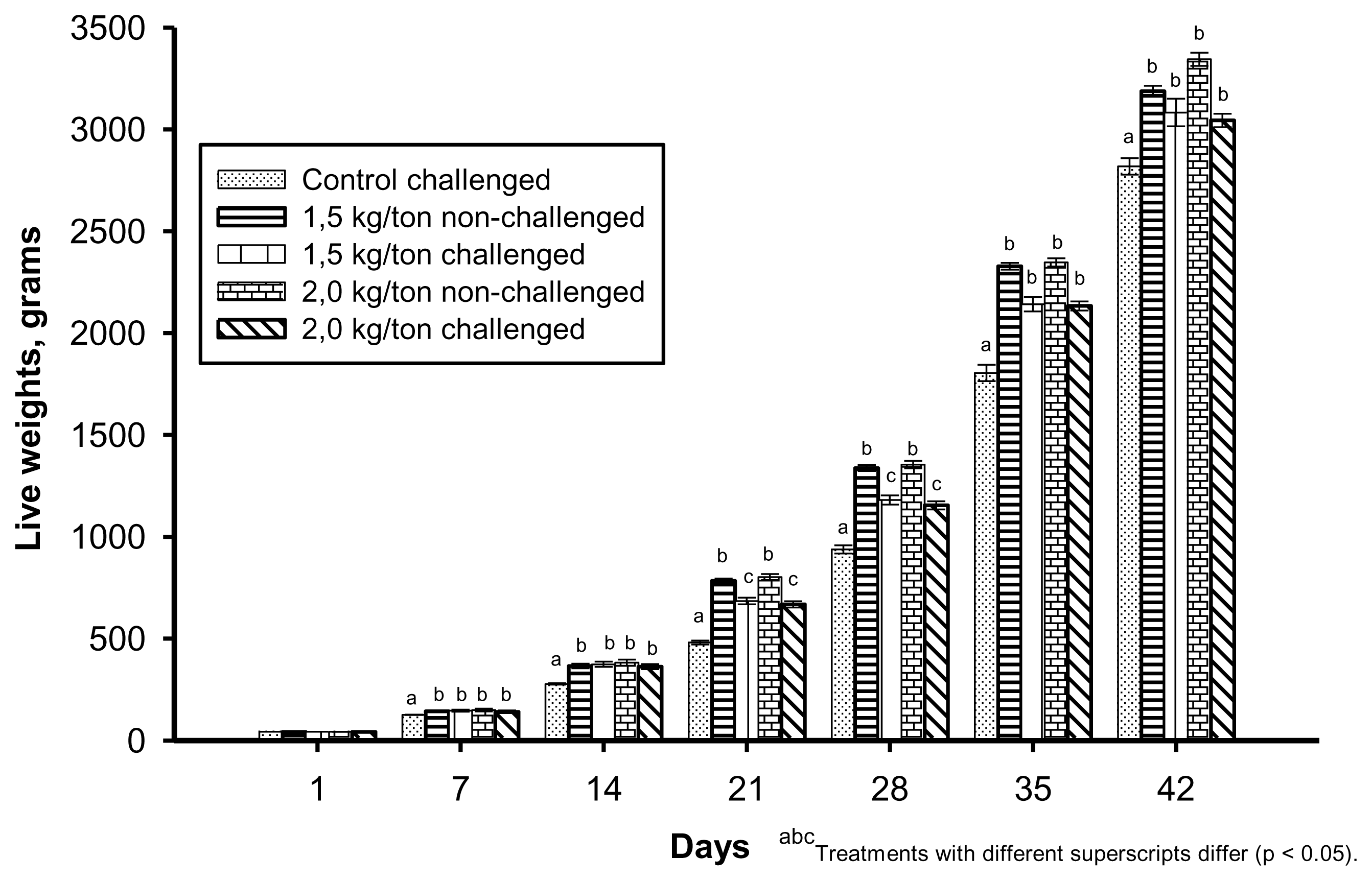Bedford M. 2000. Removal of antibiotic growth promoters from poultry diets: Implications and strategies to minimise subsequent problems. World’s Poult Sci J 56:347–365.

Bess F, Favero A, Vieira SL, Torrent J. 2012. The effects of functional oils on broiler diets of varying energy levels. J Appl Poult Res 21:567–578.

Caspary WF. 1992. Physiology and pathophysiology of intestinal absorption. Am J Clin Nutr 55:299S–308S.

Conway DP, McKenzie ME, Dayton AD. 1990. Relationship of coccidial lesion scores and weight gain in infections of
Eimeria acervulina,
E. maxima, and
E. tenella in broilers. Avian Pathol 19:489–496.


Isabel B, Santos Y. 2009. Effects of dietary organic acids and essential oils on growth performance and carcass characteristics of broiler chickens. J Appl Poult Res 18:472–476.

Itokawa H, Totsuka N, Nakahara K, Maezuru M, Takeya K, Kondo M. 1989. A quantitative structure-activity relationship for antitumor activity of long-chain phenols from
Ginko biloba L. Chem Pharm Bull 37:1619–1621.

Jang IS, Ko YH, Yang HY, Ha JS, Kim JY, Kang SY, Yool DH, Naml DS, Kim DH, Lee CY. 2004. Influence of essential oil components on growth performance and functional activity of the pancreas and small intestine in broiler chickens. Asian Australas J Anim Sci 17:394–400.

Johnson J, Reid WM. 1970. Anticoccidial drugs: lesion scoring techniques in battery and floor-pen experiments with chickens. Exp Parasitol 28:30–36.


Kubo I, Komatsu S, Ochi M. 1986. Molluscicides from the cashew Anacardium occidentale and their large-scale isolation. J Agric Food Chem 34:970–973.

Kubo I, Nihei K, Tsujimoto K. 2003. Antibacterial action of anacardic acids against Methicillin Resistant
Staphylococcus aureus(MRSA). J Agric Food Chem 51:7624–7628.


López CAA, Lima KRS, Manno MC, Tavares FB, Neto Fernandes DL, Jesus MLC, Viana MAO, Fonseca LAB. 2012. Effects of cashew nut shell liquid (CNSL) on the performance of broiler chickens. Arq Bras Med Vet Zootec 64:1027–1035.

Luna GC. 1968. Manual of Histologic Staining Methods of the Armed Forces Institut of pathology. 3. edMc Graw-Hill; New York, USA: p. 285
Maenz DD, Forsyth GW. 1982. Ricinoleate and deoxycholate are calcium ionophores in jejunal brush border vesicles. J Membr Biol 70:125–133.


Matterson LD, Potter LM, Stutz NW, Singsen EP. 1965. The metabolizable energy of feed ingredients for chickens. Res Rep 7:3–11.
McDougald LR. 1998. Intestinal protozoa important to poultry. Poult Sci 77:1156–1158.


Muroi H, Kubo I. 1996. Antibacterial activity of anacardic acid and totarol, alone and in combination with methicillin, against methicillin resistant
Staphylococcus aureus. J Appl Bacteriol 80:387–394.


Novak AF, Clark GC, Dupuy HP. 1961. Antimicrobial activity of some ricinoleic and oleic acid derivatives. J Am Oil Chem Soc 38:321–324.

Rostagno HS, Albino LFT, Donzele JL, Gomes PC, Oliveira RF, Lopes DC, Ferreira AS, Barreto LST. 2005. Brazilian tables for poultry and swine: Composition of feedstuffs and nutritional requirements. 2 edViçosa, UFV; Brazil:
Sakomura NK, Rostagno HS. 2007. Research methods in nutrition of monogastrics. Jaboticabal: FUNEP; p. 283
SAS Institute. 2007. SAS User’s Guide: Version 7.0 edn. SAS Inst Inc; Cary, NC, USA:
Tedesco D. 2001. The potentially of herbs and plant extracts as feed additives in livestock production. Zootec Nutr Anim 27:111–133.
Toyomizu M, Okamoto K, Ishibashi T, Chen Z, Nakatsu T. 1999. Uncoupling effect of anacardic acids from cashew nut shell oil on oxidative phosphorylation of rat liver mitochondria. Life Sci 66:229–234.

Vieira C, Fetzer S, Sauer SK, Evangelista S, Averbeck B, Kress M, Reeh PW, Cirillo R, Lippi A, Maggi CA, Manzini S. 2001. Pro- and anti-inflammatory actions of ricinoleic acid: similarities and differences with capsaicin. Naunyn Schmiedebergs Arch Pharmacol 364:87–95.


Voeten AC. 1985. Recent developments in the field of anticoccidial agents for poultry. Recent Advances in Animal Nutrition. Haresign W, Cole DJA, editorsButterworth & Co; London: p. 292–303.

Xu ZR, Hu CH, Xia MS, Zhan XA, Wang MQ. 2003. Effects of dietary fructooligosaccharide on digestive enzyme activities, intestinal microflora and morphology of male broilers. Poult Sci 82:1030–1036.










 PDF Links
PDF Links PubReader
PubReader ePub Link
ePub Link Full text via DOI
Full text via DOI Full text via PMC
Full text via PMC Download Citation
Download Citation Print
Print





